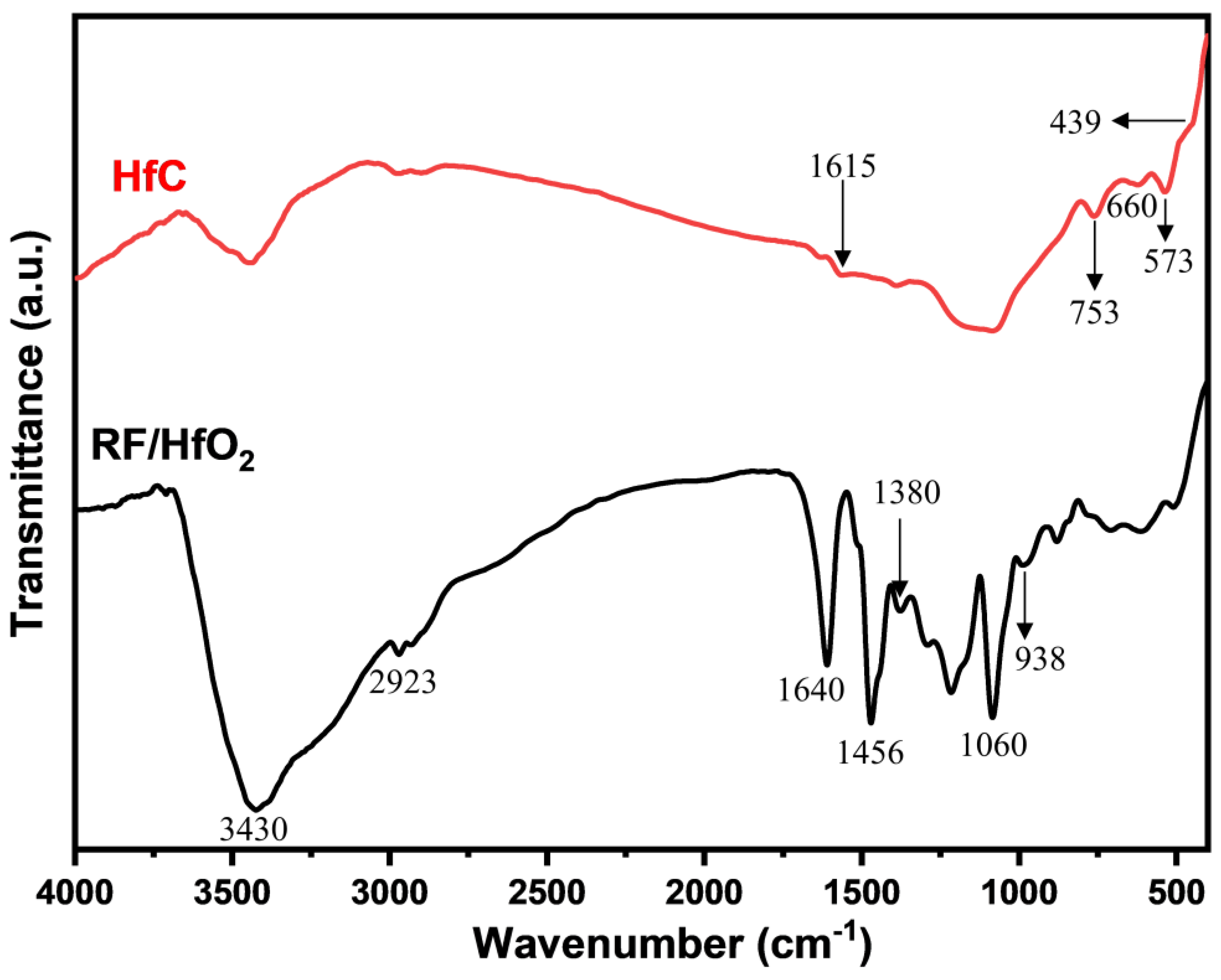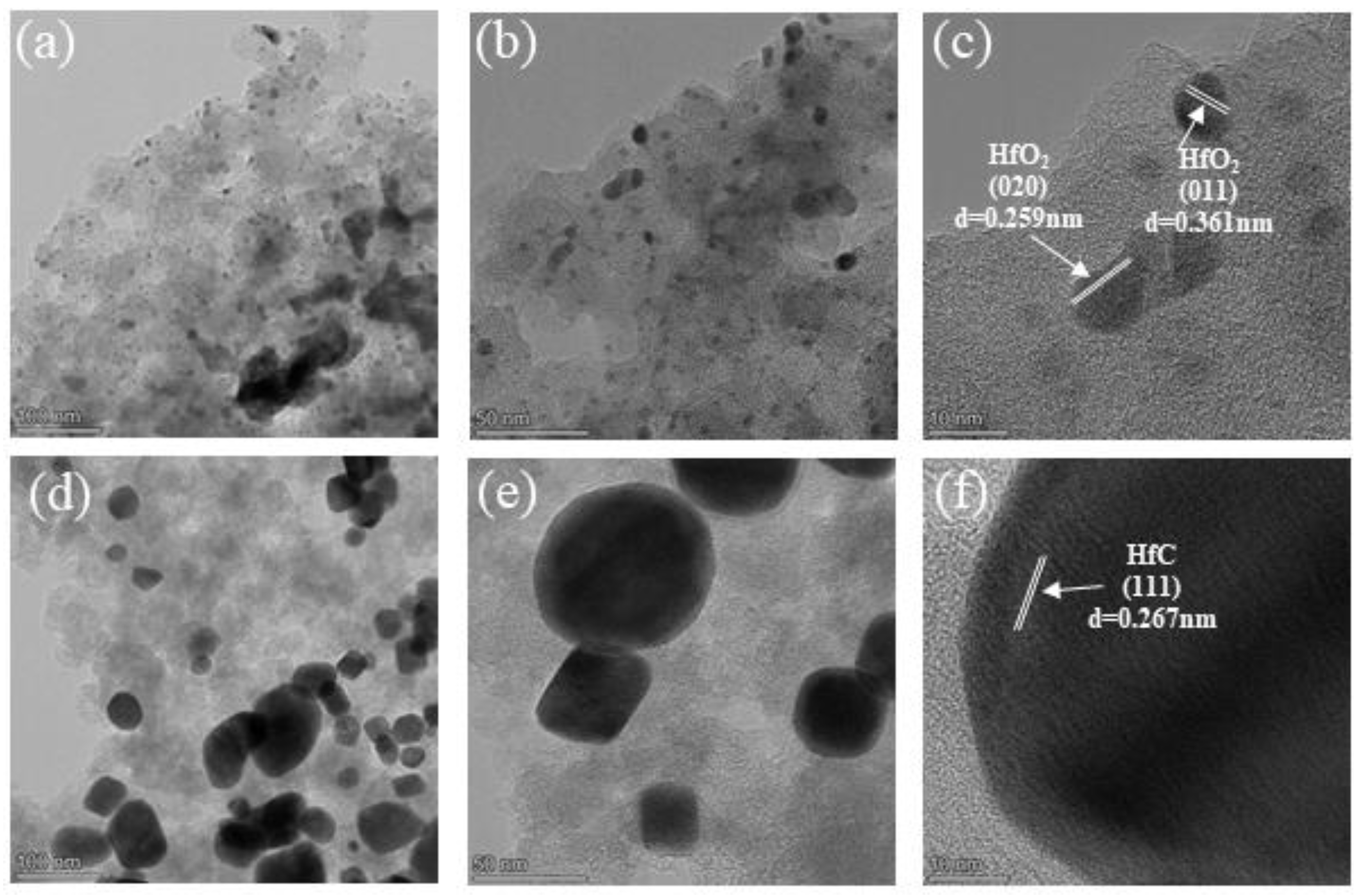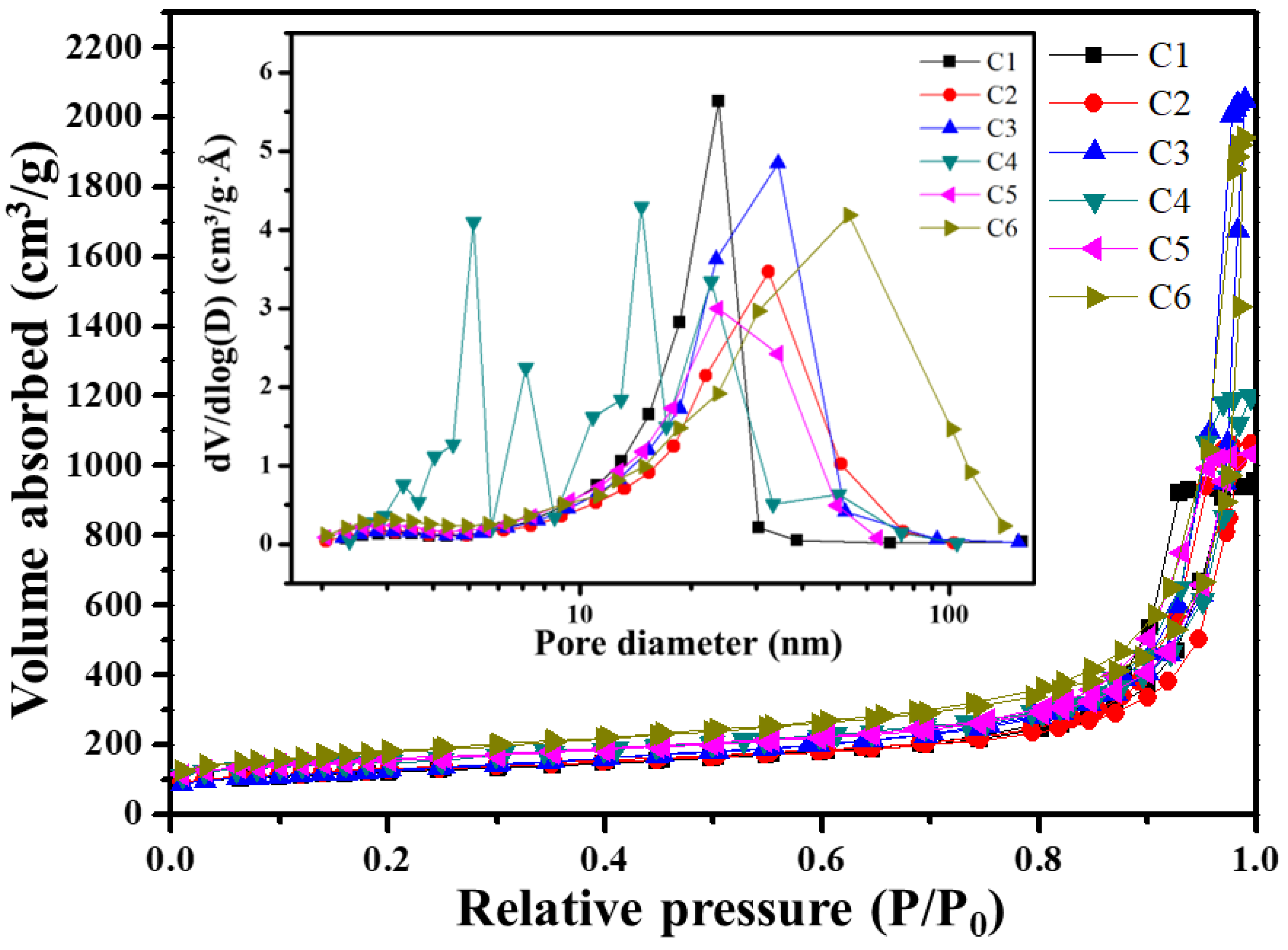Facile Preparation of a Novel HfC Aerogel with Low Thermal Conductivity and Excellent Mechanical Properties
Abstract
:1. Introduction
2. Results and Discussion
2.1. Thermal Conductivity and Compressive Strength Analysis
2.2. Synthetic Route and Reaction Mechanism Analysis
2.3. Chemical Composition and Structural Analysis
2.4. Thermogravimetric and Pore Morphology Analysis
3. Conclusions
4. Materials and Methods
4.1. Materials
4.2. Synthesis
4.3. Characterizations
Supplementary Materials
Author Contributions
Funding
Institutional Review Board Statement
Informed Consent Statement
Data Availability Statement
Acknowledgments
Conflicts of Interest
References
- Chen, Y.X.; Klima, K.M.; Brouwers, H.J.H.; Yu, Q. Effect of silica aerogel on thermal insulation and acoustic absorption of geopolymer foam composites: The role of aerogel particle size. Compos. B Eng. 2022, 242, 110048. [Google Scholar] [CrossRef]
- Liu, S.; Wu, X.; Li, Y.; Cui, S.; Shen, X.; Tan, G. Hydrophobic in-situ SiO2-TiO2 composite aerogel for heavy oil thermal recovery: Synthesis and high temperature performance. Appl. Therm. Eng. 2021, 190, 116745. [Google Scholar] [CrossRef]
- Wang, C.; Yang, S.; Ma, Q.; Jia, X.; Ma, P.C. Preparation of carbon nanotubes/graphene hybrid aerogel and its application for the adsorption of organic compounds. Carbon 2017, 118, 765–771. [Google Scholar] [CrossRef]
- Maleki, H.; Hüsing, N. Current status, opportunities and challenges in catalytic and photocatalytic applications of aerogels: Environmental protection aspects. Appl. Catal. B 2018, 221, 530–555. [Google Scholar] [CrossRef]
- Ferreira-Gonçalves, T.; Iglesias-Mejuto, A.; Linhares, T.; Coelho, J.M.; Vieira, P.; Faísca, P.; Reis, C.P. Biological thermal performance of organic and inorganic aerogels as patches for photothermal therapy. Gels 2022, 8, 485. [Google Scholar] [CrossRef] [PubMed]
- Zhao, J.; Pan, R.; Sun, R.; Wen, C.; Zhang, S.L.; Wu, B.; Zhang, Z.B. High-conductivity reduced-graphene-oxide/copper aerogel for energy storage. Nano Energy 2019, 60, 760–767. [Google Scholar] [CrossRef]
- Liu, Z.H.; Ding, Y.D.; Wang, F.; Deng, Z.P. Thermal insulation material based on SiO2 aerogel. Constr Build Mater. 2016, 122, 548–555. [Google Scholar] [CrossRef]
- Wagle, R.; Yoo, J.K. Preparation of highly porous Al2O3 aerogel by one-step solvent-exchange and ambient-pressure drying. Int. J. Appl. Ceram. Technol. 2020, 17, 1201–1212. [Google Scholar] [CrossRef]
- Liu, B.; Liu, X.; Zhao, X.; Fan, H.; Zhang, J.; Yi, X.; Gao, M.; Zhu, L.; Wang, X. High-strength, thermal-stable ZrO2 aerogel from polyacetylacetonatozirconium. Chem. Phys. Lett. 2019, 715, 109–114. [Google Scholar] [CrossRef]
- Parale, V.G.; Kim, T.; Phadtare, V.D.; Yadav, H.M.; Park, H. Enhanced photocatalytic activity of a mesoporous TiO2 aerogel decorated onto three-dimensional carbon foam. J. Mol. Liq. 2019, 277, 424–433. [Google Scholar] [CrossRef]
- Kong, Y.; Zhong, Y.; Shen, X.; Gu, L.; Cui, S.; Yang, M. Synthesis of monolithic mesoporous silicon carbide from resorcinol–formaldehyde/silica composites. Mater. Lett. 2013, 99, 108–110. [Google Scholar] [CrossRef]
- Lu, W.; Steigerwalt, E.S.; Moore, J.T.; Sullivan, L.M.; Collins, E.W.; Lukehart, C.M. Carbothermal transformation of a graphitic carbon nanofiber/silica aerogel composite to a SiC/silica nanocomposite. J. Nanosci. Nanotechnol. 2004, 4, 803–808. [Google Scholar] [CrossRef] [PubMed]
- Leventis, N.; Sadekar, A.; Chandrasekaran, N.; Sotiriou-Leventis, C. Click synthesis of monolithic silicon carbide aerogels from polyacrylonitrile-coated 3D silica networks. Chem. Mat. 2010, 22, 2790–2803. [Google Scholar] [CrossRef]
- Kong, Y.; Zhong, Y.; Shen, X.; Cui, S.; Fan, M. Effect of silica sources on nanostructures of resorcinol–formaldehyde/silica and carbon/silicon carbide composite aerogels. Microporous Mesoporous Mat. 2014, 197, 77–82. [Google Scholar] [CrossRef]
- An, Z.; Zhang, R.; Fang, D. Synthesis of monolithic SiC aerogels with high mechanical strength and low thermal conductivity. Ceram. Int. 2019, 45, 11368–11374. [Google Scholar] [CrossRef]
- Ye, L.; Qiu, W.; Li, H.; Zhao, A.; Cai, T.; Zhao, T. Preparation and characterization of ZrCO/C composite aerogels. J. Sol-Gel Sci. Technol. 2013, 65, 150–159. [Google Scholar] [CrossRef]
- Cui, S.; Suo, H.; Jing, F.; Yu, S.; Xue, J.; Shen, X.; Lin, B.; Jiang, S.; Liu, Y. Facile preparation of ZrCO composite aerogel with high specific surface area and low thermal conductivity. J. Sol-Gel Sci. Technol. 2018, 86, 383–390. [Google Scholar] [CrossRef]
- Ren, S.; Liu, K.; Wang, K.; Fan, J.; Liang, J.; Yang, C. ZrC/C aerogel with high compressive strength by a carbothermic process. J. Eur. Ceram. Soc. 2021, 41, 4710–4719. [Google Scholar] [CrossRef]
- Sayir, A. Carbon fiber reinforced hafnium carbide composite. J. Mater. Sci. 2004, 39, 5995–6003. [Google Scholar] [CrossRef]
- Zheng, K.; Gao, J.; Hei, H.; Wang, Y.; Yu, S.; He, Z.; Tang, B.; Wu, Y. Design and fabrication of HfC, SiC/HfC and HfC-SiC/HfC interlayers for improving the adhesion between diamond coatings and cemented carbides. J. Alloys Compd. 2020, 815, 152405. [Google Scholar] [CrossRef]
- Kim, D.; Han, J.; Park, C.; Lee, H.G.; Park, J.Y.; Kim, W.J. Chemical vapor deposition of dense hafnium carbide from HfCl4–C3H6–H2 system for the protection of carbon fibers. Adv. Eng. Mater. 2019, 21, 1800730. [Google Scholar] [CrossRef]
- Matović, B.; Babić, B.; Bučevac, D.; Čebela, M.; Maksimović, V.; Pantić, J.; Miljković, M. Synthesis and characterization of hafnium carbide fine powders. Ceram. Int. 2013, 39, 719–723. [Google Scholar] [CrossRef]
- Kim, J.; Lee, S.J.; Feng, L.; Silvestroni, L.; Sciti, D.; Lee, S. Effect of residual excess carbon on the densification of ultra-fine HfC powder. J. Eur. Ceram. Soc. 2020, 40, 1801–1810. [Google Scholar] [CrossRef]
- Feng, L.; Lee, S.; Wang, H. Synthesis and densification of nano-crystalline hafnium carbide powder. J. Eur. Ceram. Soc. 2015, 35, 4073–4081. [Google Scholar] [CrossRef]
- Chen, Y.; Yang, H.; Nie, J.; Zhu, X. Synthesis of highly flexible silica aerogels by photoacids generation. J. Porous Mat. 2018, 25, 1027–1034. [Google Scholar] [CrossRef]
- He, F.; He, X.; Yang, W.; Zhang, X.; Zhou, L. In-situ synthesis and structural characterization of cellulose-silica aerogels by one-step impregnation. J. Non-Cryst. Solids 2018, 488, 36–43. [Google Scholar] [CrossRef]
- Wang, X.; Zhou, Z.; Guo, X.; He, Q.; Hao, C.; Ge, C. Ultrasonic-assisted synthesis of sodium lignosulfonate-grafted poly (acrylic acid-co-poly (vinyl pyrrolidone)) hydrogel for drug delivery. Rsc Adv. 2016, 6, 35550–35558. [Google Scholar] [CrossRef]
- Wang, X.; Zhang, L.; Wang, Y. Preparation of HfC-SiC ultra-high-temperature ceramics by the copolycondensation of HfC and SiC precursors. J. Mater. Sci. 2022, 57, 4467–4480. [Google Scholar] [CrossRef]
- Han, L.; Chen, Y.; Zhang, H.; Li, G.; Jia, Q.; Zhang, S. Low-temperature synthesis of six-principal-component high-entropy transition-metal carbide aerogel thermal insulator. J. Am. Ceram. Soc. 2023, 106, 841–847. [Google Scholar] [CrossRef]








| Sample | Bulk Density (g/cm3) | Compressive Strength (MPa) | Thermal Conductivity (W/(m·K)) |
|---|---|---|---|
| C1 | 0.57 | 6.12 ± 0.13 SD | 0.053 ± 0.003 SD |
| C2 | 0.50 | 5.22 ± 0.09 SD | 0.055 ± 0.005 SD |
| C3 | 0.53 | 4.03 ± 0.19 SD | 0.056 ± 0.005 SD |
| C4 | 0.49 | 3.45 ± 0.21 SD | 0.059 ± 0.012 SD |
| C5 | 0.45 | 3.11 ± 0.07 SD | 0.060 ± 0.009 SD |
| C6 | 0.37 | 2.45 ± 0.11 SD | 0.062 ± 0.023 SD |
| Sample | Hf/R Molar Ratio | Gelation Time (min) |
|---|---|---|
| C1 | 0.25:1 | 176 |
| C2 | 0.5:1 | 158 |
| C3 | 0.75:1 | 115 |
| C4 | 1:1 | 81 |
| C5 | 1.5:1 | 65 |
| C6 | 2:1 | 46 |
| Sample | BET Surface Areas (m2/g) | Average Pore Diameters (nm) |
|---|---|---|
| C1 | 407.33 | 16.20 |
| C2 | 420.66 | 19.23 |
| C3 | 433.53 | 22.01 |
| C4 | 514.29 | 10.95 |
| C5 | 538.66 | 15.68 |
| C6 | 601.02 | 23.34 |
Disclaimer/Publisher’s Note: The statements, opinions and data contained in all publications are solely those of the individual author(s) and contributor(s) and not of MDPI and/or the editor(s). MDPI and/or the editor(s) disclaim responsibility for any injury to people or property resulting from any ideas, methods, instructions or products referred to in the content. |
© 2023 by the authors. Licensee MDPI, Basel, Switzerland. This article is an open access article distributed under the terms and conditions of the Creative Commons Attribution (CC BY) license (https://creativecommons.org/licenses/by/4.0/).
Share and Cite
Wang, W.; Wu, Z.; Song, S.; You, Q.; Cui, S.; Shen, W.; Wang, G.; Zhang, X.; Zhu, X. Facile Preparation of a Novel HfC Aerogel with Low Thermal Conductivity and Excellent Mechanical Properties. Gels 2023, 9, 839. https://doi.org/10.3390/gels9100839
Wang W, Wu Z, Song S, You Q, Cui S, Shen W, Wang G, Zhang X, Zhu X. Facile Preparation of a Novel HfC Aerogel with Low Thermal Conductivity and Excellent Mechanical Properties. Gels. 2023; 9(10):839. https://doi.org/10.3390/gels9100839
Chicago/Turabian StyleWang, Wei, Zhanwu Wu, Shicong Song, Qi You, Sheng Cui, Weimin Shen, Guoqing Wang, Xuanfeng Zhang, and Xiaofei Zhu. 2023. "Facile Preparation of a Novel HfC Aerogel with Low Thermal Conductivity and Excellent Mechanical Properties" Gels 9, no. 10: 839. https://doi.org/10.3390/gels9100839
APA StyleWang, W., Wu, Z., Song, S., You, Q., Cui, S., Shen, W., Wang, G., Zhang, X., & Zhu, X. (2023). Facile Preparation of a Novel HfC Aerogel with Low Thermal Conductivity and Excellent Mechanical Properties. Gels, 9(10), 839. https://doi.org/10.3390/gels9100839






